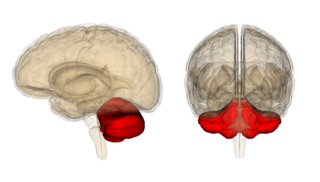Cognition
Social Cognition May Rely Heavily on a Healthy Cerebellum
Damage to specific regions of the "little brain" may impair social perceptions.
Posted November 22, 2019 Reviewed by Devon Frye
It's understandable why so many people overlook the cerebellum (Latin for "little brain") when thinking about our ability to interpret other people's actions and read body language.
Until the late 1990s, just about everyone on the planet (with the exception of Jeremy Schmahmann of Harvard Medical School) strongly believed that our "little brain" wasn't involved in any non-motor functions related to cognition.

In the last decade of the 20th century, Schmahmann began working closely with ataxia patients who traveled from all parts of the globe to consult with the thought leaders at Harvard's Massachusetts General Hospital (MGH).
Many of the ataxia patients Schmahmann worked with at MGH had damage to microzones within the cerebellum that did not appear to disrupt motor functions but did negatively impact various non-motor functions.
Based on his keen observation of how damage to specific regions of the cerebellum affected various non-motor functions, Schmahmann is widely regarded as the first neurologist to document how dysfunction or damage to certain microzones or "lobules" within the cerebellar cortex affect various aspects cognition.
In 1998, Schmahmann and his MGH colleague, Janet Sherman, published a game-changing landmark paper, "The Cerebellar Cognitive Affective Syndrome (CCAS)" in the journal Brain.
This paper (1998) introduced the world to a new acronym, CCAS, which is also referred to as "Schmahmann's Syndrome." This terminology is currently used by neurologists to describe "a constellation of deficits in the cognitive domains of executive function, spatial cognition, language, and behavior that stem from damage to the cerebellum." (See "Jeremy Schmahmann Untangles the Perplexity of Our Cerebellum.")
Flash forward to 2019: It's been over two decades since Schmahmann et al. opened our eyes to the possibility of various regions of the cerebellum playing a role in non-motor functions. On November 18, MGH celebrated the 25th anniversary of its world-renowned ataxia unit and announced that Jeremy Schmahmann is launching a new Massachusetts General Hospital Ataxia Center.
Additionally, a new paper was published this week by researchers from the Social Brain Lab and Cerebellar Coordination and Cognition Group in the Netherlands that may advance our understanding of CCAS.
On November 21, the journal Brain published new findings (2019) that elucidate how someone's perception of another person's physical actions and body movements recruits the "little brain." This paper also identifies some specific ways that cerebellum-related disorders such as spinocerebellar ataxia can alter social cognition.
This YouTube video illustrates how the latest research on a possible link between the cerebellum and social cognition was conducted and sums up the findings.
"Our results contribute to an increased awareness that neurological disorders affecting the cerebellum could have consequences for social perception. Being impaired in perceiving what other individuals around us do is likely to impact the way we relate to others and thereby reduce our wellbeing," the authors said.
For this pioneering research on a possible link between damage to the cerebellum and impaired social cognition, a team of researchers from the Netherlands Institute for Neuroscience (NIN) led by Valeria Gazzola started by using fMRI to study healthy study participants as they observed goal-directed hand actions of other people. These fMRI neuroimages showed that action perception of others by healthy individuals bilaterally recruited lobules VI, VIIb and VIIIa in both cerebellar hemispheres.
Next, as part of a deeper dive into the perceptual abilities of the cerebellum, the NIN researchers did the same experiments with a cohort of patients suffering from SCA6, which is an ataxia-related disease that damages specific regions of the cerebellum.
What were their findings? "Whereas healthy subjects (n = 31) were found to be able to discriminate subtle differences in the kinematics of observed limb movements of others, patients suffering from spinocerebellar ataxia type 6 (SCA6; n = 21) were severely impaired in performing such tasks," the authors write.
Based on these findings, the authors conclude: "Our data suggest that the human cerebellum is actively involved in perceiving the kinematics of the hand actions of others and that SCA6 patients' deficits include a difficulty in perceiving the actions of other individuals. This finding alerts us to the fact that cerebellar disorders can alter social cognition."
It's important to note that although the cerebellum appears to play a role in social cognition, the various lobules of the cerebellum involved in social perception are most likely just a "link in the chain" that helps to optimize whole-brain functions relating to social cognition.
Building on a bicycle chain metaphor, Gazzola summed up how these recent cerebellar findings (2019) fit into the bigger picture. In a news release, Gazzola concluded: "If you remove the chain of your bicycle, it will no longer move forward. But that doesn't mean it was the chain alone that drove the bike. What it does show is that the cerebellum is a critical part of a cognitive system—a part we had neglected for too long. And we must realize that problems with the cerebellum will most likely impair aspects of social cognition, and that this requires support and patience."
References
Abdel R. Abdelgabar, Judith Suttrup, Robin Broersen, Ritu Bhandari, Samuel Picard, Christian Keysers, Chris I. De Zeeuw, Valeria Gazzola. "Action Perception Recruits the Cerebellum and Is Impaired in Patients with Spinocerebellar Ataxia." Brain (First published: November 21, 2019) DOI: 10.1093/brain/awz337
Jeremy D. Schmahmann and Janet C. Sherman. "The Cerebellar Cognitive Affective Syndrome." Brain (First published: April 1, 1998) DOI: 10.1093/brain/121.4.561




